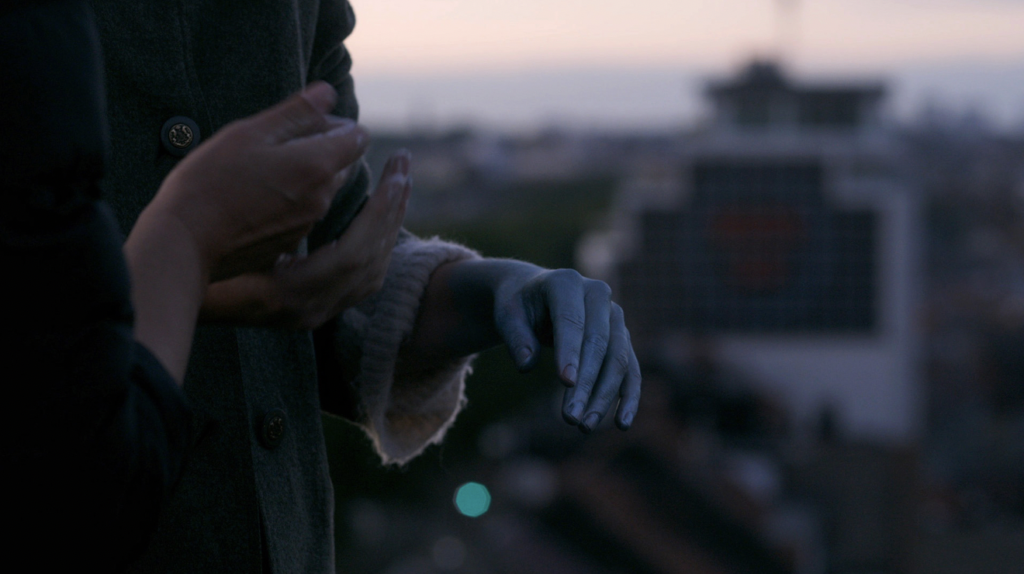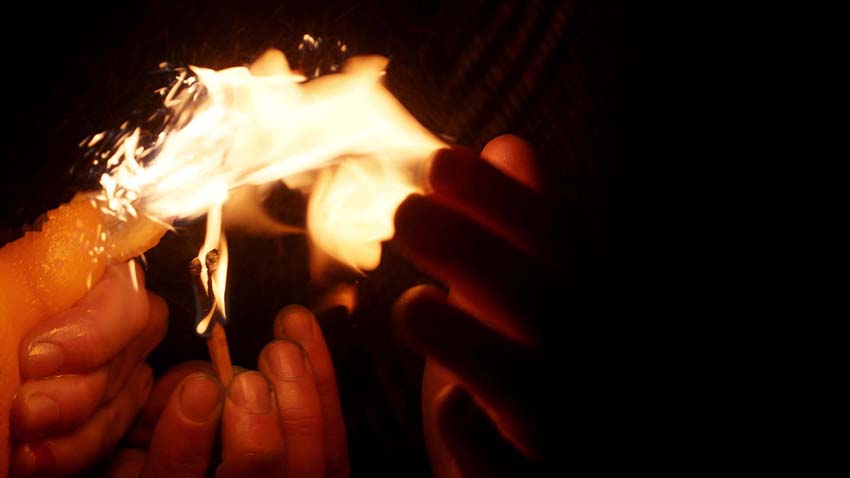Partners / Alex Reynolds / Conversation with Alma Söderberg on "La mano que canta"
Partners: Alex Reynolds
La mano que canta is a film produced by Alex Reynolds as part of the work for Communities in Movement. The film developed from an ongoing collaboration with Alma Söderberg. It captures the sensorial interplay passing across site and sound, voice and gesture, figuring a poetic meditation on listening, friendship, and film.
About half a year before filming we sat down and wrote a text together. We could follow each other’s writing live in a google document and like that had a silent conversation. Today we are struck by how many things were hidden in the text that we didn’t know would happen, like mini oracles. Now, in May 2021, we will try to repeat the exercise and write a new live text from where we are now, three months after the first screening of the film. The finished film. But is it though? Is it ever finished? Where are we now in our conversation? How does the work resound and resonate today with and in-between us? What can we dream up next?

Malmö, March 2020
Alex: To make the room and its contents the looking machine, but also the resonance box, the mixing board. To make the filming apparatus performative, in the present tense.
Alma: Using the voice to listen to the hand and the hand to listen to the voice. Together they form an instrument that allows for synthesising; the shaping and reshaping of frequencies. But as the voice listens to the hand listening to the voice other things: words, gestures, sentences, stories, conversations, rise to the surface. What is beyond this seemingly closed loop? The hand held up before the camera and the hand holding the camera become instruments for listening, they vibrate together like a hum that shakes the relation.
Alex: To steer away from the violence of being looked at, could the gaze of someone upon us be received as a gift? Whoever has been in love knows the freedom one feels when the person we love turns their gaze upon us. But not because it sees us the way we are or how we like to be seen; it sees beyond what we knew of ourselves. More than a confirmation, the loving camera eye pushes us to expand and grow, pointing to spaces we had no idea we could fill. How liberating it might be to be seen, not as you imagine you are, but to be misunderstood.
Alma: People move around in the background. We think about background and foreground and about how listening is a good tool to move into the depths of seeing. The ear is a camera lens.
Alex: To think about belonging; to belong, to believe something belongs to us. To thrive in a language that is never fully yours. Not to ever take language for granted, it can be taken away from you. It is learned anew with every uttering. There are more languages to contend with because each has its limits as to what it can hold. Some things cannot be told, but can be shown.
Alma: Someone mentions the outskirts of language. We are also there. We are walking through ruins of language and remnants of words, we pick some up, we toss them around. We wonder how everything relates to everything as we film a hand that has a voice. We think about ghosts.
Alex: We struggle against anything that denies vibration. A hand holds a mirror too long and the image trembles and hums.
Alma: We listen until we are not safe anymore.
Malmö - Brussels, May 2021
Alma: What does friendship sound like? Or look like? Not when represented but when practiced in film? The friendship between the two of us, but also between the sound and the image. An oscillation, a wave, a ping pong game, a rhythm, a song.
Alex: Brandon spoke of a current of sympathy running through the film. I wonder if this could be a definition of friendship.
Alma: We work a lot with synchronicity in the film, something we have both also worked with in previous works of ours. I think about the relation between synchronicity and sympathy, being with the feeling and being with the time. Flawed (felt) synchronicity: sometimes on point, sometimes slightly off. Or as if the point we are trying to hit is roomy, spacious, generous towards us. Like when I was sounding the wings of a bird. The sound didn’t have to go with each beat of the wings, but there was a feeling of the bird in me.
Alex: Perhaps it is not so much about the synchronicity being successful or efficient, but the magic is in the trying, in the blur. It involves listening and speaking at the same time, tuning in. To really listen when you speak is one of the hardest things.
Alma: And this is also how you film. You listen as you film.
Alex: On the way to the studio today I was thinking of a sentence by Machado that I go back to once in a while. “The eye is not an eye because you see it, it is an eye because it sees you.” And in the film this eye, which could also be an ear, or skin, a sentient being, was in everything. We didn’t want to approach what was in front of the camera like an object, we wanted to be attentive to its looking, talking or singing back, to imagine that we had a shared language to see and hear it. Like with a friend.
Alma: I keep thinking of the sentence “Do something with the sound as if it was your friend” by Fred Moten.
Alma: We had written about people moving in the background and how the camera lens was an ear, but instead of people they were leaves.
Alex: And in the singing of the leaves we did narrow down the room a little, there was more precision needed in the synchronicity... The opening up of ears and eyes here was all brought about by an obsessive attention to detail. During the confinement it was like a warm cave I could enter, the editing room, with your voice, the rain, the music slowly coming out of the image. Yet the voice always needed to be fragile, off key at times, trying something for the first time… Listening with your eye and tuning into the image with your voice, feeling that you might have been there, next to the camera, trying to make the leaves sing, but so close that you could sound the camera movements too.
Alma: Yesterday I watched a Tiny Desk Concert with Alicia Keys and she started off with an intro and a song called Show me love. She spoke about how important it is in difficult times to show love; to actively affirm, to show up, to make gestures of love, to say the words, to do the actions. I think that many of the procedures we use in the film are trying to show love to the material itself. To affirm it, to show it it’s not just rushes, or raw material, but that there is richness and depth in each thing.
Alex: This makes me think as well of a conversation I had with Andrea and Carolina when the far right was entering the government in Spain… We were full of rage and disappointment and dread. And we spoke of love and laughter and the importance of affirming it, to refuse to let them poison everything. But is it ok to sit and listen to a forest and make it sing when the world is on fire? “Nuestra venganza será ser felices” appeared in a picture of a performance I saw, and I still hold onto it.
I also think about the old form-content nut a lot lately. And how attention to form is more important than ever. Yesterday I read an article about a Maori politician in New Zealand who performed a haka in parliament after denouncing racism and was kicked out because of it. Someone said: “There are various worlds here, and they are colliding”.
Alma: The day before yesterday I watched an interview with Chassol and he spoke about how when he has filmed materials and he looks at it, it feels like a black page. A page of eternal depth and richness, not a blank, not something to fill up.
Alex: There is an attention that refuses to reduce, that feels a word running through your mouth, what it does to your tongue, what it does to the air... People who see the film talk about an intense attention to detail, and how through the tiniest thing a whole universe emerges.
In the first text you wrote: “We wonder how everything relates to everything”. And I think about how much of the film is in the transitions. How the transitions bring so many things together, make them clash and resonate with one another, wash off the image that came before it but let the sound vibrate or rhyme to a new image or a new movement. As we edited it became clear that nothing could be still for too long. Nothing should keep the sound we expect it to make for too long. We didn’t want anything fixed, we also didn’t want any protagonists. It was the world at once, vibrating. Reading The Waves gave me that feeling. I remember reading it and walking out onto the street and feeling everything intensify and shimmer.
Another thing that stayed from the book was the sentence ”Look at the street now that Percival is dead”. Woolf often talks about someone entering or exiting a room and how in their presence everything transforms. That lingering hum or rhythm, the resonance of a word we heard at the beginning, that sticks to an image or drips off a hand, I think that is now very much the film. And in the first text there was also this sentence: “we think of ghosts”... We could think of sounds as ghosts, having an afterlife after their enunciation.
Alma: Happening after they happened. Perhaps the ghost of Federico Garcia Lorca. He lives on in some of the words we gravitate towards: Manantial, Lagarto, Luna....
Alex: Lorca is so present in our love, yours and mine, of the Spanish language! The words, but also the musicality; el niño la mira mira, el niño la está mirando...
Alma: I love that poem and song sung by Paco Ibañez. Perhaps in our next work we can work more closely with this.
Alex: Si!
